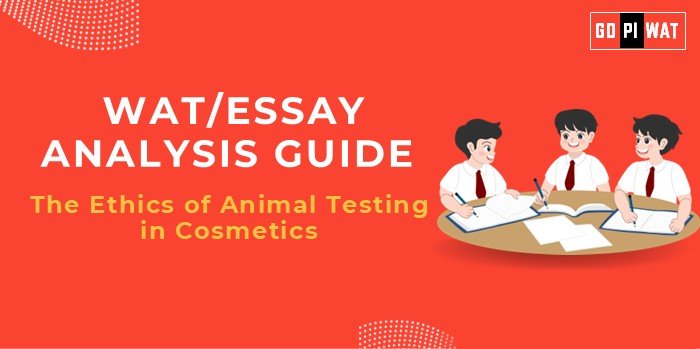📋 WAT/Essay Analysis Guide: The Ethics of Animal Testing in Cosmetics
🌟 Understanding the Topic’s Importance
The debate ties into broader themes of corporate social responsibility, ethical decision-making, and technological advancements. It challenges students to evaluate ethical dilemmas against business constraints.
⏳ Effective Planning and Writing
- 📝 Time Allocation:
- Planning: 5 minutes
- Writing: 20 minutes
- Review: 5 minutes
- 📚 Preparation Tips:
- Research key statistics and market trends.
- Understand alternative testing methods.
- Note legislative milestones globally.
📖 Introduction Techniques for Essays
- ⚖️ Contrast Approach: “While animal testing ensures human safety, it raises ethical concerns about the unnecessary suffering of millions of animals.”
- 💡 Problem-Solution Approach: “Animal testing in cosmetics remains a controversial topic, but technological advancements offer a cruelty-free future.”
- 📜 Historical Lens: “The use of animals in cosmetic testing has a long history, but ethical and technological revolutions are reshaping its future.”
📚 Structuring the Essay Body
1. Achievements:
- ✔️ Legislative Bans: Over 40 countries, including the EU and India, have outlawed animal testing for cosmetics.
- ✔️ Technological Progress: Alternatives like in-vitro testing, AI-based models, and organ-on-chip technology.
- ✔️ Market Trends: Growing demand for cruelty-free products, with a market valued at $8 billion in 2023.
2. Challenges:
- ❌ Cost Issues: Developing alternatives can be expensive and time-consuming.
- ⚠️ Technological Limitations: Some toxicity tests still lack reliable non-animal substitutes.
- 🌍 Resistance from Certain Markets: Countries like China require animal testing for imported products.
3. Future Outlook:
- 🌟 Encourage global collaborations for regulatory alignment.
- 💼 Promote innovation incentives to develop scalable testing alternatives.
- 📣 Raise consumer awareness to drive demand for cruelty-free practices.
🔚 Concluding Effectively
- 🌀 Balanced Perspective: “While progress has been made, a unified global approach is vital to ending animal testing in cosmetics.”
- 🌍 Future-Oriented Conclusion: “Technological advancements hold the key to ethical and sustainable cosmetic testing.”
✍️ Sample Short Essays
1. Balanced Perspective:
“Animal testing for cosmetics is an ethical dilemma balancing human safety against animal welfare. Countries like the EU show that safety standards can be upheld without animal harm. However, challenges such as cost and resistance from countries like China highlight the need for global collaboration to implement humane practices.”
2. Solution-Oriented:
“Animal testing can become obsolete with investments in alternatives like organ-on-chip models. Legislative bans, coupled with innovation incentives, could make cruelty-free testing a universal norm.”
3. Global Comparison:
“The EU’s ban on animal testing contrasts sharply with China’s mandatory requirements, highlighting the ethical divide. A global consensus is essential to address this issue holistically.”


